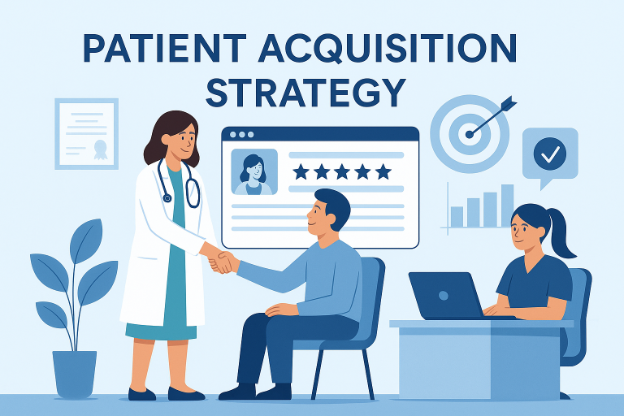A strong patient acquisition strategy is the foundation of growth for any successful medical practice. Whether you’re opening a new clinic, entering a new market, or trying to expand your patient base, attracting new patients requires a multi-channel approach that blends visibility, trust, and efficiency.
In today’s competitive healthcare landscape, relying on word-of-mouth isn’t enough. You need clear tactics, measurable goals, and the right tools to stand out and grow. In this guide, we’ll walk through the essential elements of an effective patient acquisition plan and how to turn new patients into long-term advocates.
1. Define Your Ideal Patient Personas
Before you begin building your patient acquisition strategy, it’s important to understand exactly who you want to reach. Ask yourself:
- What are the age, gender, and demographics of your ideal patients?
- What conditions or services are they seeking?
- Where do they spend time online?
- What problems are they trying to solve?
The clearer your patient persona, the easier it will be to target the right audience and tailor your messaging accordingly.
2. Optimize Your Online Presence
Today, most patients start their healthcare search online. That’s why your website and digital reputation are critical to any modern patient acquisition plan. Make sure your:
- Website is mobile-friendly, fast-loading, and easy to navigate.
- Services are clearly explained with strong CTAs.
- Contact forms and appointment scheduling are simple and visible.
- Patient reviews and testimonials are highlighted.
Incorporate SEO best practices by using relevant keywords, writing location-based content, and optimizing page titles and meta descriptions. For more on managing your digital reputation, visit our blog on building a stellar digital reputation.
3. Focus on Local SEO and Google Business Profile
Local SEO is one of the most effective ways to capture new patients searching in your area. A well-optimized Google Business Profile ensures your clinic shows up in local map packs and “near me” searches. Be sure to:
- Keep your NAP (name, address, phone number) consistent across all listings.
- Upload high-quality images of your clinic and staff.
- Collect and respond to Google reviews.
- Post regular updates with service highlights or promotions.
These small efforts go a long way in supporting your patient acquisition strategy and improving your clinic’s discoverability. For more ideas, check out our top local SEO strategies to boost your healthcare practice’s visibility.
4. Build Strong Referral Relationships
Referrals remain a powerful source of new patient traffic. Cultivate relationships with:
- Primary care physicians.
- Specialists in adjacent fields.
- Physical therapists and rehab centers.
- Local businesses and community organizations.
Create referral kits with your clinic’s information, make it easy to refer, and keep partners informed about the care their referrals receive.

5. Streamline Your Patient Intake Process
Once a new patient contacts your clinic, the experience should be simple and frictionless. A poor onboarding experience can derail an otherwise successful patient acquisition effort. Focus on:
- Online intake forms and insurance pre-verification.
- Appointment reminders and confirmations via text or email.
- Friendly, informed front-desk staff.
Every touchpoint should feel seamless and patient-focused.
6. Leverage Paid Advertising Strategically
When done right, digital advertising can supercharge your patient acquisition strategy. Consider:
- Google Ads targeting location-specific searches
- Facebook and Instagram ads with geo-targeting and service promotions
- Retargeting ads for website visitors who didn’t convert
Make sure to track conversions and adjust your strategy based on performance metrics. For additional insight, explore our guide on boosting patient engagement through digital marketing for podiatry practices.
7. Track Key Metrics and Adjust Accordingly
No strategy is complete without analytics. To ensure your patient acquisition efforts are working, track:
- Website traffic and conversion rates.
- Cost per lead (CPL) and cost per acquisition (CPA).
- Referral sources.
- New patient volume over time.
These insights allow you to double down on what’s working and cut what isn’t.
Final Thoughts
An effective patient acquisition strategy is not one-size-fits-all. It requires ongoing effort, optimization, and alignment with your clinic’s values and goals. By combining digital tools, human connection, and clear processes, your practice can consistently attract and retain the right patients.
At Allevio Care, we help healthcare providers create scalable growth strategies tailored to their goals. Contact us today to see how we can support your practice’s expansion, from smarter marketing to streamlined operations.






